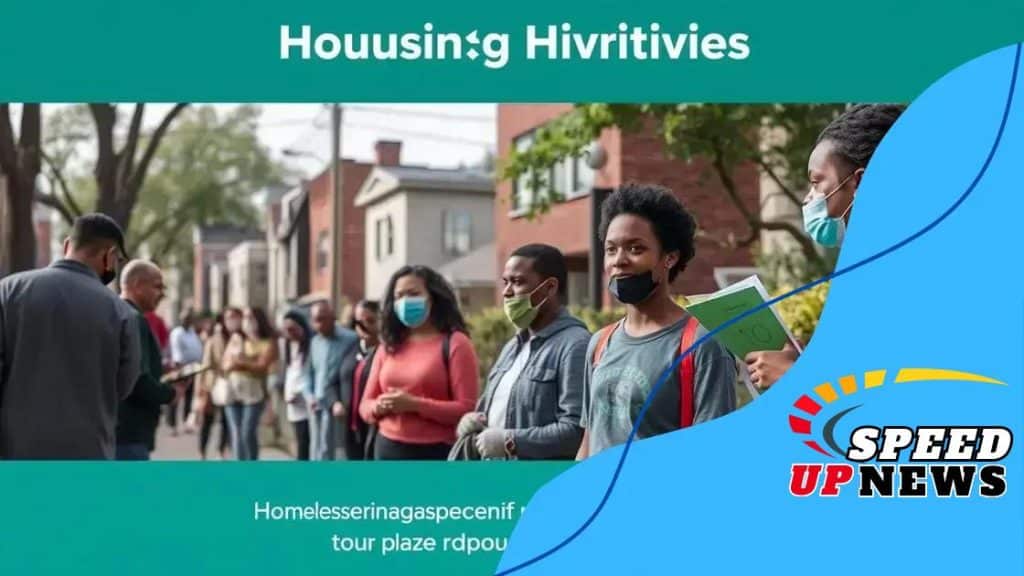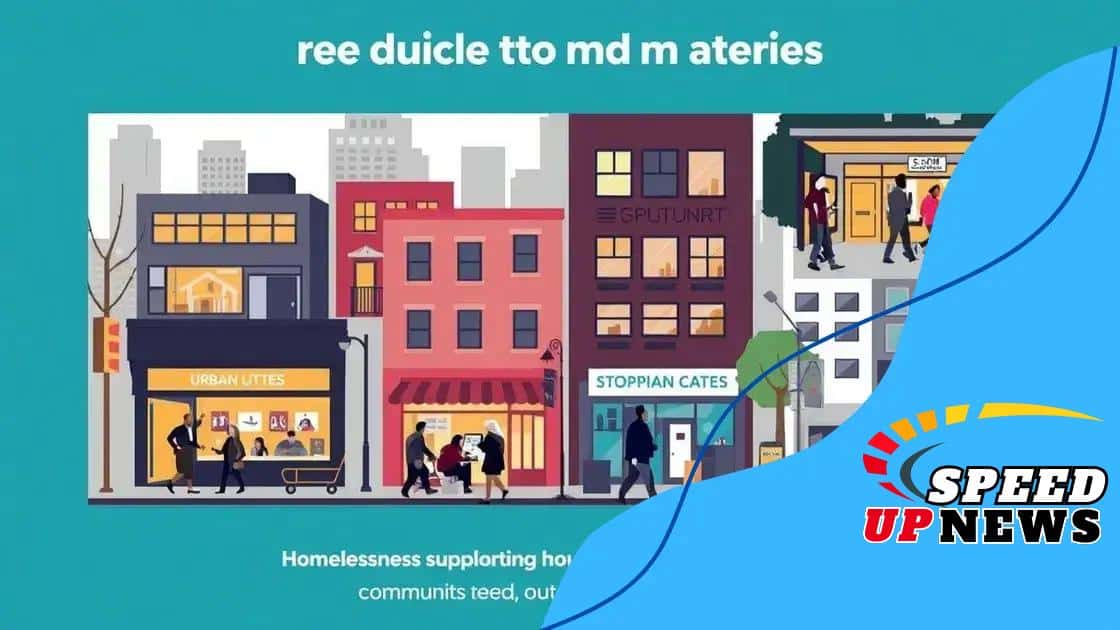Preventative homelessness programs in major cities: a new hope

Preventativa homelessness programs in major cities aim to address the root causes of homelessness through strategies like the housing-first approach, integrated support services, and community engagement, ultimately helping individuals maintain stable housing and improve their quality of life.
Preventative homelessness programs in major cities aim to address the root causes of homelessness before they escalate. Have you ever considered how specific initiatives can not only provide immediate relief but also create lasting change? Let’s dive into the impactful strategies cities are implementing.
Understanding homelessness in urban environments
Understanding homelessness in urban environments is crucial for addressing the issue effectively. Many factors contribute to this problem, including economic challenges, social issues, and lack of supportive housing options. By exploring these elements, cities can develop more targeted preventative strategies.
The economic impact on homelessness
Economic hardship plays a significant role in homelessness. Many individuals face job loss or underemployment, making it difficult to afford housing. As a result, they may find themselves in precarious living situations.
Social factors contributing to homelessness
Social issues, such as mental health and addiction, are also key contributors. Without proper support services, individuals may struggle to maintain stable housing. Community programs that offer assistance can make a significant difference.
- Access to job training: Programs that provide job skills can help individuals gain employment.
- Mental health support: Providing access to mental health services is essential for those in crisis.
- Affordable housing initiatives: Cities must prioritize creating affordable housing options.
Another important aspect is the role of community organizations. These groups often help bridge the gap between the homeless population and available resources. They connect individuals with shelters, healthcare services, and employment opportunities. By fostering collaboration among various stakeholders, communities can create a supportive network for those in need. Additionally, local governments can implement policies that address the root causes of homelessness, such as poverty and discrimination.
As we tackle the issue of homelessness in urban areas, understanding its complexities is essential. Only through comprehensive approaches that address both economic and social factors can we hope to create lasting change.
Key preventative strategies in cities
Key preventative strategies in cities are essential for addressing homelessness effectively. By implementing these strategies, communities can provide more than just temporary relief; they offer long-term solutions that foster stability and security.
Housing-first approach
The housing-first model prioritizes providing stable housing before addressing other issues like job placement or mental health treatment. This model has proven successful in many cities, as it allows individuals to focus on rebuilding their lives once they have a safe place to live.
Integrated support services
Offering integrated support services is vital in tackling homelessness. Access to healthcare, counseling, and job training can help individuals transition from homelessness to stability. Cities that collaborate with local organizations often see better outcomes.
- Case management: Personalized case management helps individuals navigate available resources.
- Job training programs: Providing skills training can improve employment opportunities.
- Mental health services: Ensuring access to mental health care is critical for long-term success.
Another effective strategy is the prevention of eviction. Helping residents develop plans to stay in their homes is crucial. Financial assistance can make a big difference, along with mediation services that address disputes between landlords and tenants. Community outreach and education programs can inform individuals about their rights and available resources.
In addition, fostering partnerships between local businesses and government can create job opportunities specifically tailored for those at risk of homelessness. These alliances can help break the cycle of poverty while ensuring that community members receive the support they need to thrive. As cities adopt these strategies, they move closer to solving complex housing issues.
Successful case studies of major cities

Successful case studies of major cities provide valuable insights into effective approaches for reducing homelessness. These examples highlight strategies that have made a real difference in the lives of individuals and families experiencing housing insecurity.
New York City’s initiatives
New York City has implemented various programs aimed at preventing homelessness. The city’s Homebase program focuses on providing families with the support they need to avoid eviction. It combines financial aid with case management. As a result, many families are able to stay in their homes and avoid the cycle of homelessness.
Los Angeles’ housing-first approach
Los Angeles is known for its housing-first approach, which prioritizes placing individuals into permanent housing as a first step. This model has proven successful in decreasing the number of people living on the streets. With readily available support services, formerly homeless individuals can rebuild their lives more effectively.
- Impact on mental health: This approach has been shown to improve mental health outcomes by providing stability.
- Community integration: With housing, individuals can reconnect with their communities and develop strong support systems.
Seattle also provides a noteworthy example through its navigation centers, where individuals can access comprehensive services in a supportive environment. These centers help people find housing, job training, and health services, all in one place. By streamlining access to resources, the city has seen positive results.
These case studies illustrate that cities can effectively reduce homelessness through thoughtful, comprehensive strategies. As communities continue to learn from one another, the possibility of eradicating homelessness becomes more achievable.
Challenges faced by these programs
Challenges faced by these programs can hinder efforts to prevent homelessness. While many cities implement innovative approaches, various obstacles can impact their effectiveness.
Funding limitations
One significant challenge is the lack of adequate funding. Many programs rely on government grants or donations, which can fluctuate. Insufficient resources can lead to reduced services or program closures, leaving vulnerable populations without help.
Stigma and public perception
Stigma surrounding homelessness often complicates efforts to implement solutions. Many communities resist programs designed to help homeless individuals, fearing negative impacts on property values or safety. Addressing these perceptions through education and awareness is essential.
- Community engagement: Involving local residents in discussions can help reduce stigma.
- Promoting success stories: Sharing positive outcomes from funded programs can build support.
- Advocacy and outreach: Engaging with policymakers can secure more resources and support for these initiatives.
Another challenge involves coordinated services. Many organizations provide essential support, but coordination often lacks. When services do not work together, individuals may face hurdles in accessing the assistance they need. A more integrated approach can help overcome these barriers.
Data collection and analysis present additional difficulties. Without reliable data, it is challenging to assess the effectiveness of programs. Cities need accurate statistics to identify trends and improve their strategies effectively. Ensuring that data is collected and analyzed helps refine approaches and better serve the community.
How communities can support these initiatives
How communities can support these initiatives is vital for the success of preventative homelessness programs. Active involvement from local residents can create a more welcoming and supportive environment for those in need.
Volunteer programs
Community members can participate in volunteer programs that assist local shelters and outreach initiatives. These programs often need hands-on help with meal services, organizing donations, and providing educational workshops. Volunteers can make a significant difference in the lives of individuals who are experiencing homelessness.
Educational initiatives
Raising awareness about homelessness is essential. Communities can host educational initiatives that inform residents about the challenges faced by homeless individuals. These initiatives may include seminars, workshops, and community discussions aimed at fostering understanding and empathy.
- Collaborative events: Organizing events that bring together local businesses and non-profits can create a strong support network.
- Fundraisers: Hosting fundraising events can provide vital financial support for programs aimed at reducing homelessness.
- Advocating for policy changes: Community members can engage with local government officials to advocate for policies that support housing stability.
Additionally, creating partnerships with local businesses can enhance available resources. Businesses can offer job training programs specifically tailored to homeless individuals. This not only provides meaningful employment opportunities but also strengthens the local economy.
By fostering a sense of community and driving engagement, local residents can significantly contribute to the effectiveness of preventative programs. Neighborhoods that actively support these initiatives create a culture of compassion and understanding that benefits everyone.
FAQ – Frequently Asked Questions about Preventative Homelessness Programs
What are preventative homelessness programs?
Preventative homelessness programs aim to address the root causes of homelessness before individuals lose their housing, focusing on support services and resources.
How can my community get involved in supporting these programs?
Communities can volunteer, raise awareness, organize fundraising events, and advocate for policies that help people facing homelessness.
What are some successful strategies used in major cities?
Successful strategies include the housing-first approach, integrated support services, and educational initiatives that inform the public about homelessness.
What challenges do these programs face?
Challenges include funding limitations, stigma from the community, lack of coordination among services, and difficulties in data collection and analysis.





